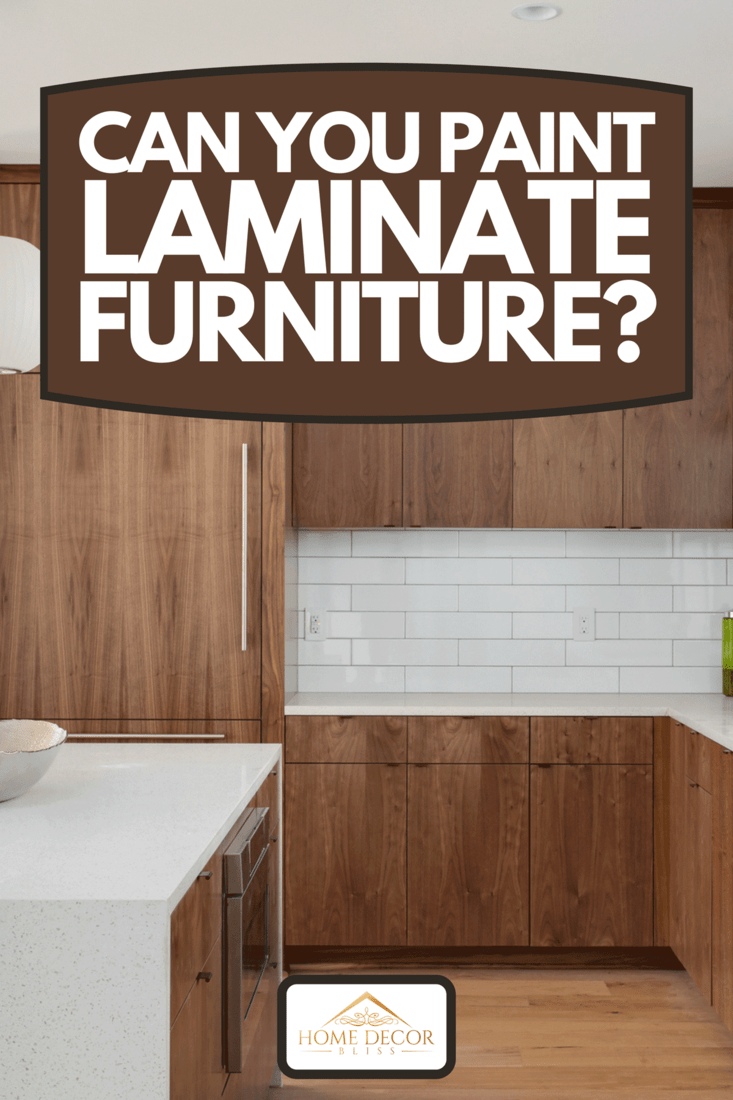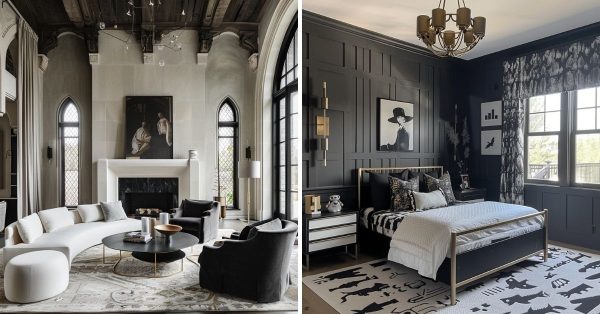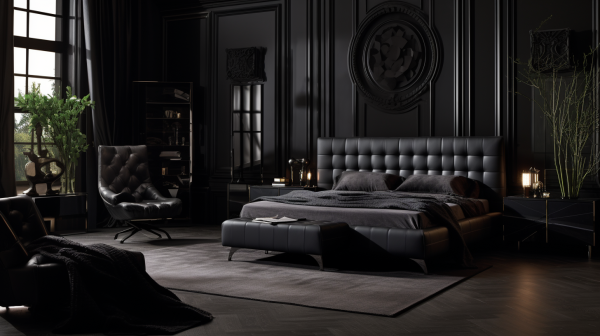Your laminated wood cabinets have become dull and worn on the exterior, and they are starting to make your room look bad. What do you do? Can you paint over the laminate furniture? Or will you need to refurbish it completely? We've done the work to bring you the answer.
Yes, oftentimes, you can paint over laminate furniture without completely refurbishing it. Depending on the furniture's current state, you can repaint the laminate and have it looking brand new in no time.
For the most part, painting laminate furniture is no different from painting furniture made of natural wood. The main difference is in the prep work done before painting the surface. Continue reading to learn about the steps involved in painting over laminate furniture.

Painting Laminate Versus Wood
Natural wood can be painted with minimal prep work, typically only requiring that primer is applied before the paint is applied. Laminated furniture, however, has a protective layer made of fibreboard that will need to be prepped before it can be painted. If the area is not prepped properly, the paint job will not last long. Now let's take a look at how to paint laminate wood furniture such as cabinets, dressers, and chests.
Steps To Paint Laminate Furniture
Things you'll need:
- 200-grit sanding block
- Wood paint
- Wood filler
- Ortibal sander
- Putty knife
- Synthetic paintbrushes
- 4-inch foam paint roller
- Primer
- Painter's tape
1. Prep the area
Lay down drop cloths around the furniture to protect the floor from paint and the accumulation of dust. If you don't have drop cloths, consider large trash bags or old bedsheets that you no longer use. Also, be sure to cover any furniture in the room as well, as dust from sanding can be cumbersome to clean up.
Once you have your drop cloths down, gather all of your tools and material and set them in the room on the side of the furniture for easy access. Next, open up any windows and doors in the room to create ventilation and avoid heavy paint fumes.
2. Remove the doors and drawers
Remove any drawers, shelving, and hardware from your laminate furniture. If you also plan to paint the interior, try to remove the pieces' backing if possible. Take this time to inspect the furniture for any holes, loose joints, or dents that may need to be repaired beforehand. Sometimes you may not recognize damaged areas on your furniture until you start to take it apart, so be sure to look at it thoroughly before moving on.
Use wood filler to fill in any crevices, gaps, or holes in the furniture. This is also a good time to check the drawers' sliders to make sure that they still have a strong bond and are not coming loose. Take a closer look at the screws on the bottom of the shelves as well.
We may include affiliate links and curated AI content to highlight top design styles.
See this wood filler on Amazon.
3. Sand the furniture
This is probably the most important step in the painting process. The smooth texture of the laminate surface is not ideal for paint applications, so sanding and priming are essential. Take a 200-grit sanding block or orbital sander and go over the furniture from top to bottom, sanding the laminate to make the surface slightly rough.
After you have finished the main piece, go over the drawers to sand them down as well. The purpose of sanding is not to completely remove the laminate layer but to roughen it up so that the paint has a better surface to bond to. Before sanding, be sure to don a dust mask, as the dust can become overwhelming. After you have sanded the furniture, take a moist sponge or cloth and wipe it clean. Next, take a dry cloth and buff it dry.
4. Apply painters tape
After you have sanded the furniture, take your painter's tape and apply it to any areas you don't wish to paint. This can include drawer boxes, the sides of the furniture piece, handles, ornamental covers, and other areas.
See this painter's tape on Amazon.
5. Apply primer
Grab an angled paintbrush and prime the sides of the dresser. After you have primed at the sides, prime the top and the front of the dresser. Use your angled brush to reach in between corners and around the handles and any ornaments. Next, prime the front of the drawers.
See this angled paintbrush set on Amazon.
After you have primed the furniture, take your 220-grit sanding block and gently sand everything down. Wipe the furniture clean using a damp sponge or cloth, and then apply a second coat of primer to ensure a smooth base for the paint job.
See this sanding block on Amazon.
5. Perform a quick inspection
Take this time to closely inspect this furniture to determine if any other areas contain dents, cracks, or holes. If so, apply your wood filler to these areas, let it dry, and then apply primer to them. Sometimes damaged areas may not show up completely until you apply your first coat of primer. Be sure to sand the areas down after applying a wood filler and before applying the primer.
6. Paint the furniture
After your last coat of primer has dried, take out your paint and apply it to the dresser. Be mindful of the amount of paint you apply to the paintbrush or roller, as you don't want to create drip marks on the furniture.
Start with the top and sides of the piece and then move on to the drawers or shelves. Once the first coat of paint has dried, apply additional coats as needed. After the paint has dried, go back and slowly remove the painter's tape.
See this latex paint on Amazon.
6. Apply protective coating
After applying two or three paint coats, apply a poly or lacquer layer to help maintain the finish. You can use your paintbrush to apply this, or you can use the foam roller for quick application. Give the finish 48 to 72 hours to dry before reassembling the furniture --it can be very sticky if you try to handle it before it dries.
See this protective poly on Amazon.
How can you tell if your furniture is laminate or veneer?
Since laminated furniture is made to look like wood, it can sometimes be difficult to tell the difference between the two right at first glance. However, one way to differentiate them from one another is to look at the furniture's surface closely.
Laminate furniture will usually have a shiny clear finish, while natural wood tends to be more grainy, even if it has a protective coating. Also, look at the consistency of the wood grain; is it the same throughout? Or does it have random patterns? If it is the same throughout, the chances are that it is laminate. If it's different, it's likely natural wood. You can also look at the furniture's edges to see if you can spot a layer of bonded material. If you can, then the furniture is laminated and not natural wood.
What kind of paint do you use on laminate?
Typically latex is recommended for laminate surfaces because of its smooth finish and durability. However, this does not mean that you cannot use oil-based paints as well.
Will chalk paint stick to laminate?
Yes, chalk paint is a great paint to consider when it comes to painting laminate surfaces. If you want, you can skip sanding the furniture when using chalk paint, though you'll still need to prime it. However, it is still recommended that you perform this step as a cautionary measure to ensure that the paint sticks to the furniture. Even if you do a light sanding with a 220-grit sanding block, it can be very beneficial to help the paint bond firmly to the surface of the laminate.
The reason chalk paint works so well is that it has special bonding ingredients that allow it to stick to smooth surfaces without peeling off easily. You also notice that the texture of chalk paint is, well, chalky. This textured finish allows the chalk paint to easily adhere to smooth surfaces without sliding down or bubbling up.
See this chalk paint on Amazon.
What kind of primer should you use on laminate?
It's important to note that laminate surfaces do not fair well with all paints and primers, only those that are specifically formulated to adhere to its smooth surface. When painting a laminate surface, be sure that the primer you use, whether it's latex or oil-based, is suitable for laminate. For the most part, painting experts recommend using an oil-based primer for painting laminate surfaces.
See this oil-based primer on Amazon.
Can you paint laminate furniture without sanding?
It is generally recommended that you sand laminate-based furniture before painting it to ensure that the paint bonds well to the surface. However, like many things, there are exceptions to the rule. If you find a fantastic bonding primer that will allow you to skip the sanding process, then you can do without this step. A solid bonding primer is key to allowing you to skip having to sand your laminate furniture. One popular choice is Zinsser primer.
See this Zinsser primer on Amazon.
Wrapping Things Up
We hope that this post has provided you with all of the information you were looking for to paint over laminate furniture effectively. Remember, the most important step when painting over laminate furniture is the prep job --a bad prep job will leave you with a bad paint job. Be sure to sand the furniture and apply a quality primer before painting your laminate furniture.
Before you go, be sure to check out our other posts:











